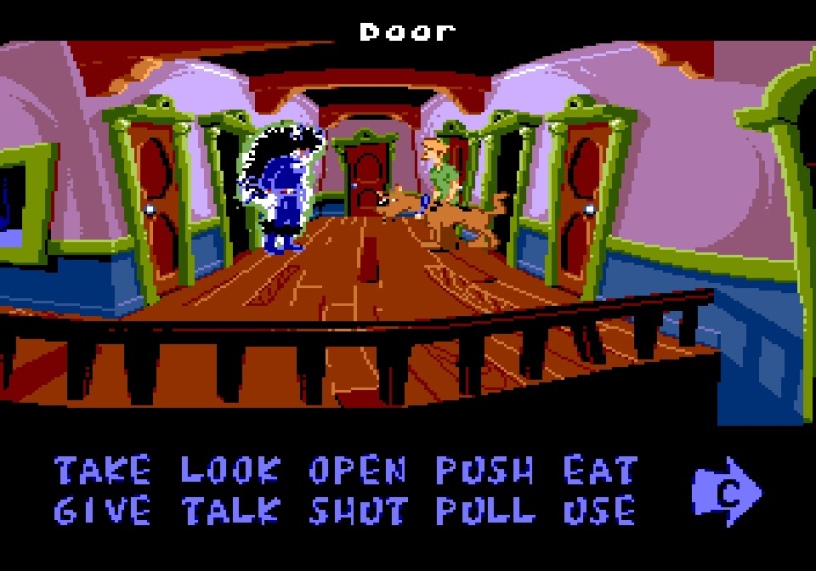I don’t think I’ve ever looked at a Sega Genesis game here before. There’s been plenty of what I usually refer to as Sega Mega Drive games, living in the United Kingdom as I do, but not specifically Sega Genesis games. I’ll come back to why it’s different this time, but what I definitely have looked at before is Scooby Doo! The first time was when I reviewed The Games That Weren’t by Frank Gasking, a wonderful, meticulous book covering decades of games that never quite got to us and why, which was preceded by my own very personal – and forever painful – experience of a game that weren’t, Scooby Doo in the Castle Mystery on the ZX Spectrum, all the way back in 1985. Of course, that wasn’t really the place to go into detail, and nor is this, because the second time was my deep-dive into the Scooby Doo game we eventually got instead on the Spectrum, which began with a detailed, step-by-step investigation, using my own magazines from the time, into where that original, jaw-dropping, actual interactive Scooby Doo cartoon ever got to. And without banging my own drum too much, it’s a fascinating read!
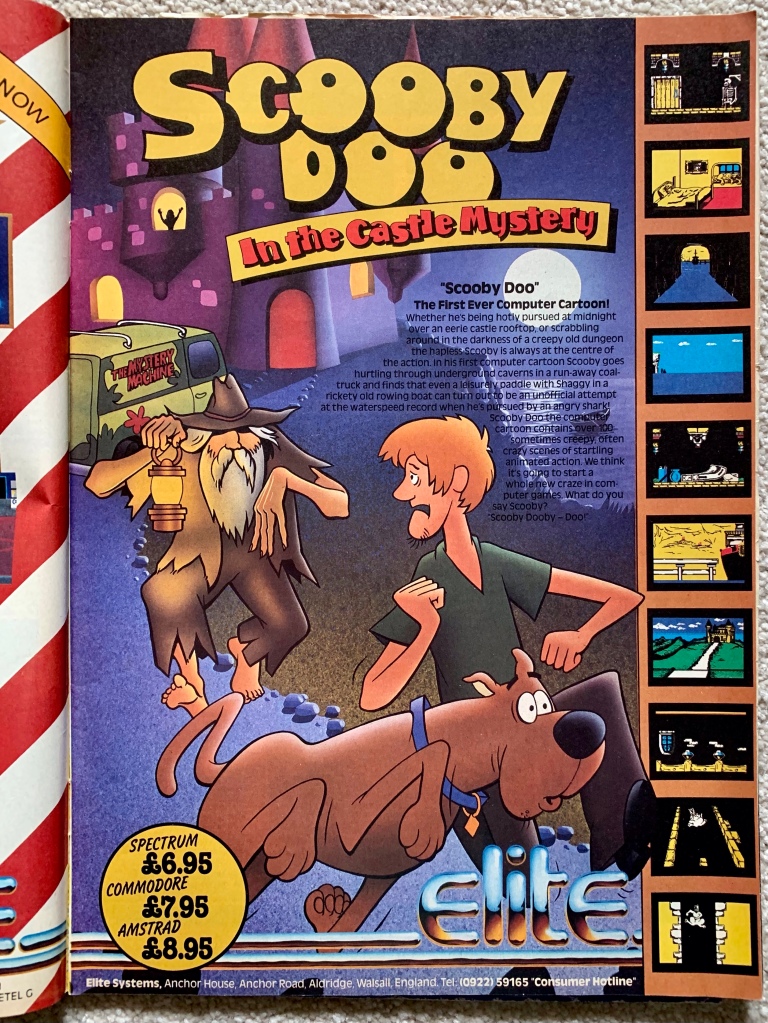
As much as I’ve always enjoyed what arrived a year later, just in time for Christmas 1986, what was now an action game (think cartoon Kung-Fu Master with a dog, maybe) was never going to capture the spirit (sorry!) or the unique atmosphere of Hanna-Barbera cartoon promised by the screenshots that teased us so cruelly in those original adverts and magazine previews! Also, just to be clear, I’m talking about Scooby Doo, Where Are You! that ran from 1969-1970 and definitely not anything from the late seventies and early eighties featuring that dreadful Scrappy Doo, who will always be in a league of his own above Godzooky, Baby Yoda and every other annoying sidekick! Apart from those though, while nothing that followed – all the way to the present day – features in my top three TV programmes of all time like those first 24 episodes did, I am pretty fond of a lot what I’ve seen of the rest since. In particular, Scooby Doo! Mystery Incorporated, which ran for fifty-two episodes from 2010-2013, is superb, returning to the gang’s early days of solving spooky mysteries in their hometown but with a modern twist and a wacky, overarching storyline, as well as nods to all kinds of proper horror, from Freddy Krueger to H.P. Lovecraft, and guest appearances from the likes of Captain Caveman and The Funky Phantom.
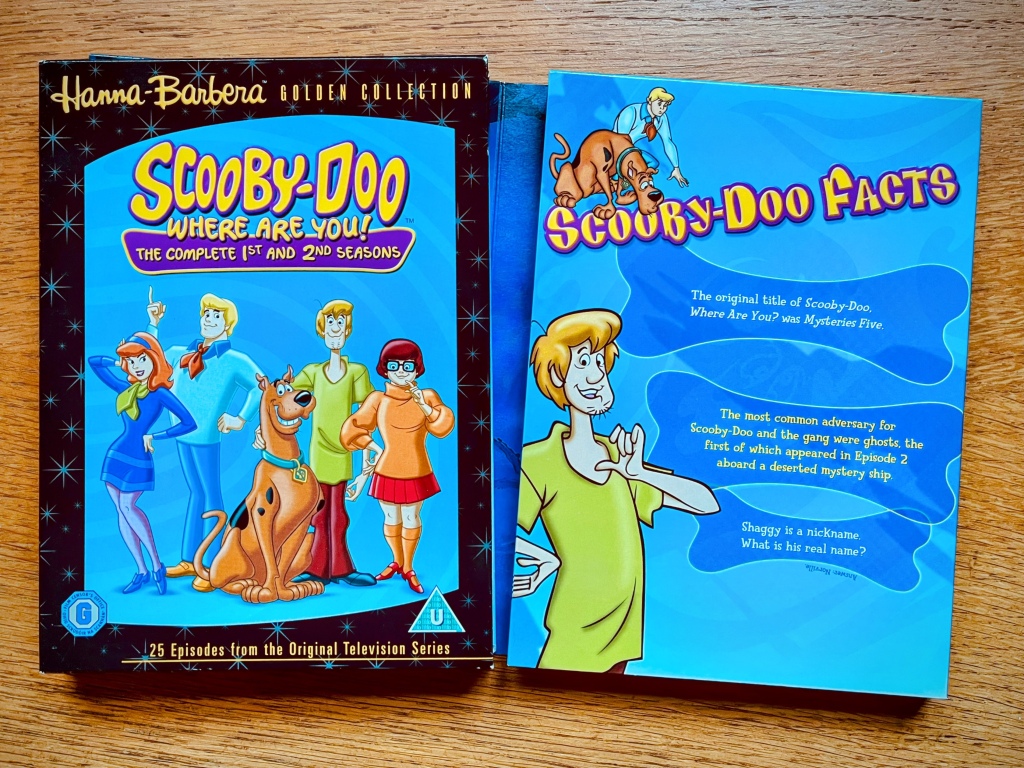
Its presentation might be way more 21st Century than Scooby Doo’s first incarnation but it really gets where that was coming from too, with a slick but retro-whimsical Southern Gothic art style, and the characters are even back in their original costumes! Staying right at the beginning, those characters, were, of course, four teenagers – Fred, the determined jock, Daphne, glamourous and danger-prone, Velma, a clever “tomboy” and Shaggy, a coward motivated by food, as well as their talking dog Scooby Doo. They went about in their van, The Mystery Machine, solving ghostly mysteries that generally ended-up with them unmasking a ne’er do well out for personal gain on the back of some local legend. Amazing to think the idea originated after protests by parental TV watch groups who objected to the violence of mid-sixties superhero cartoons! I believe it started out as being based on a musical group and was called The Mysteries Five, then the music stuff got canned, a Great Dane was installed as the star and it was retitled Who’s S-S-Scared? before one more change of name (after execs decided kids would be too s-s-scared!) gave us Scooby-Doo, Where Are You! The show was created by Joe Ruby and Ken Spears (also behind all sorts of other stuff, from Captain Caveman to the Mega Man cartoon), was produced by Hanna-Barbera and first appeared on the American CBS TV channel as part of their Saturday morning line-up in September 1969, running for two seasons until October 1971, while also being picked up by the BBC for UK TV in 1970.
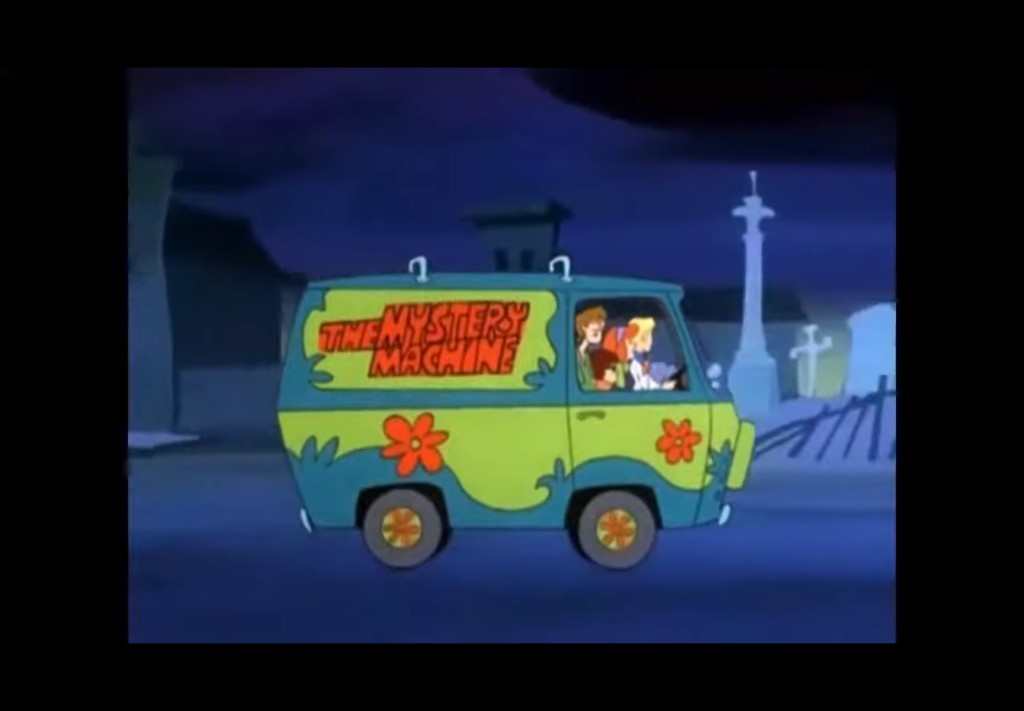
And that, of course, really was just the beginning – The New Scooby Doo Movies followed in 1973, featuring all kinds of guest stars, from the Harlem Globetrotters to Batman and Robin, then in 1976 there was The Scooby-Doo Show, then a year later Scooby’s All-Star Laff-a-Lympics, then Scrappy Doo killed several incarnations of the show for the next decade and we’ve had reimaginings, reboots, spin-offs, live action movies and more ever since. Those first two seasons will always be Scooby Doo to me though. I’ve said before it was my gateway to a lifelong passion for horror but – partly in that context – let me also tell you why it’s still one of my top three favourite TV shows. As much as characters were well defined and the slapstick humour timeless, and there’s a charm to the repeating backdrops and madcap character animation, above all it’s the atmospheric settings, and not just the cobweb-filled, crumbling haunted houses, ghost towns, creepy amusement parks and so on they had a habit of stumbling upon, but more so it was how they got to them! The sight of The Mystery Machine travelling though dark and oppressive (and endlessly repeating!) swamps will always be beautiful to me, although what I always thought was Louisiana or Florida or somewhere with that kind of bewitching Spanish moss and spectral mangrove or cypress-filled bayou setting, eventually turned out to be Southern California, around their hometown of Coolsville, and although I don’t think either were ever specifically mentioned in the shows at the time, there’s some wider conjecture that the location of Coolsville itself might be based on the geography of Ohio. But all of that comes from nerdy piecing together of much later Scooby Doo media, and if you jump to the aforementioned Mystery Incorporated, is a completely different place entirely called Crystal Cove.
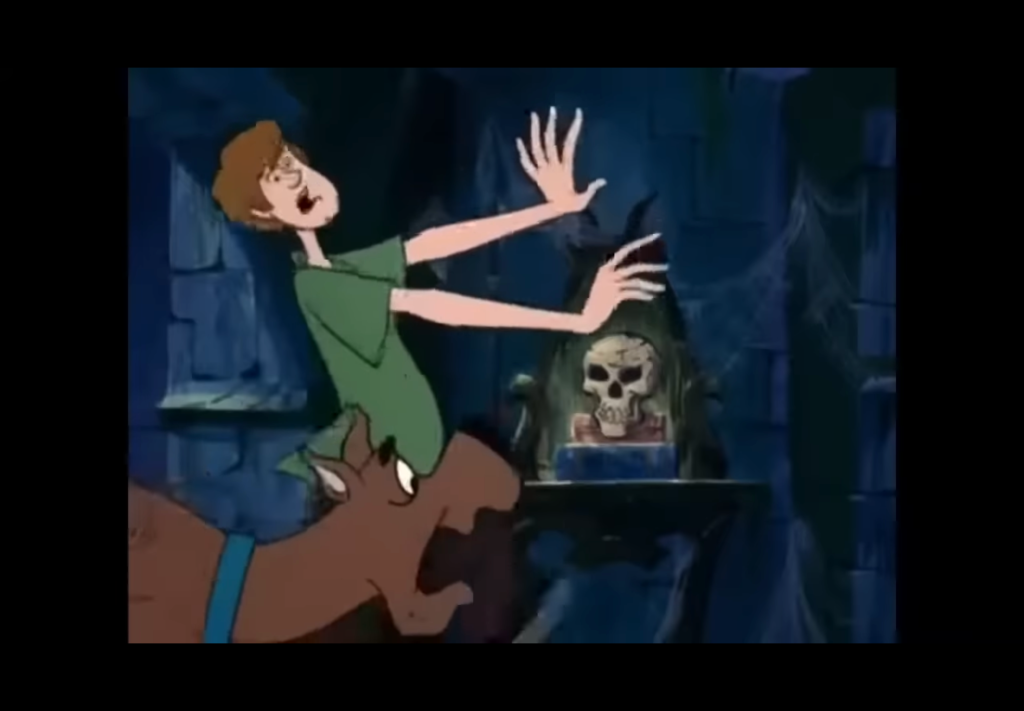
Anyway, wherever it’s set, those roads you wouldn’t want to be driving down alone at night, hiding who knows what in the blackness all those haunting, haunted trees and occasional broken fence posts are drawn on, are somehow less scary once you’re inside The Mystery Machine, with Fred, Daphne and Velma up front and Scooby and Shaggy in the back, which is something else that’s always fascinated me – what’s behind them in the back of The Mystery Machine, in that less frightening but equally intriguing darkness, and what else goes on in there? I’m not sure but I’ve always thought it seems like a warm, homely, safe place to be, like being in an old potting shed when it’s raining outside! Aside from the child-friendly hidden terrors of the classic Hanna-Barbera art style, there was also the villains, and there are several elements to why I loved these too… Right at the start of the show there was guessing with my brothers which villain it was going to be this time, as the opening credits highlighted a load of favourites; it was also the variety – there were all kinds of ghosts and ghouls, zombies, witches, monsters and even robots they came up against; finally, it was another guessing game about who the real villain was before they got unmasked by those pesky kids at the end! And while I could go on all day, let me mention that last but not least, looking at it now, it’s a real time-capsule of the end of the sixties and start of the seventies too, which is precisely the time period I was born into, so obviously there’s a big dose of where I come from on top of all that!
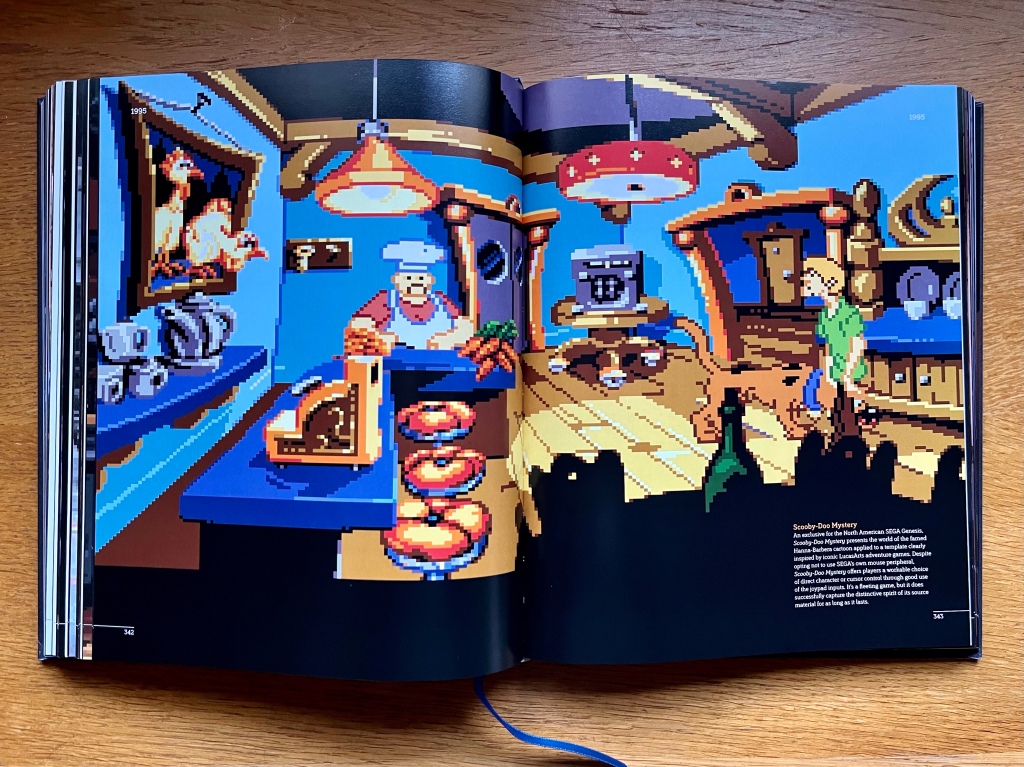
To an extent, the ZX Spectrum game from earlier captured a lot of that too, which elevated what was a very simplistic platforming beat ‘em up, where success was actually about being patient more than any combat skills, to almost being able to imagine you were in a Scooby Doo cartoon. It wasn’t quite there though, and it definitely wasn’t there like the earlier concept we’d been sold on seemed to be, but what I first saw of Scooby-Doo Mystery on the Sega Genesis possibly was… It was actually another book review that brings us to that today, this time of Bitmap Books’ The Art of Point-and-Click Adventure Games where – like the first time I watched Mystery Incorporated – I spotted something else that seemed to get where Scooby Doo was coming from, and that, of course, was Scooby-Doo Mystery for the Sega Genesis. Which I’d never even heard of before! My brother had a Mega Drive so I always had a passing interest, which I think in recent years has become much more than that, and I’ve become pretty au fait with a lot of what the system has to offer, but not this! The most probable reason why, as I alluded to at the start (and as stated by the book), is that this was a Sega Genesis North American exclusive. And a point-and-click adventure at that, rather than something more typical of a 16-bit console than a computer… And probably more typical of something several years earlier than 1995, when it was released by Acclaim, who I think picked it up from Sunsoft as they were about to go bankrupt.
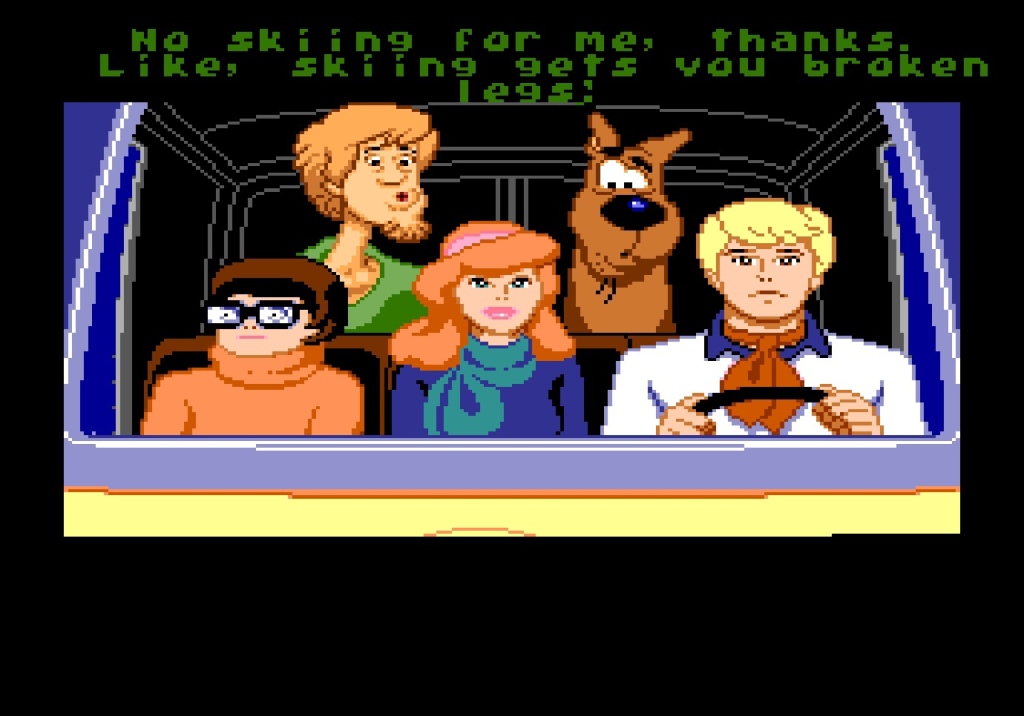
Scooby-Doo Mystery is actually two mysteries, and when you load it up – once you’ve enjoyed the most upbeat Genesis sound chip rendition of the theme tune you can imagine – you’ve got a choice of tackling either one, Blake’s Hotel or Ha Ha Carnival, as separate, unconnected, standalone adventures. Blake’s Hotel belongs to Daphne’s uncle, and here you need to find the clues that will trap the (so-called) ghost of an ancient chieftain who’s scaring away all his guests, while over at Ha Ha Carnival, a fun-filled day out turns into a mission to find a clown bent on revenge, while also rescuing Fred, Daphne and Velma from his clutches! We’ll look at each one in turn in a sec but in both cases this involves taking control of Shaggy and, in typical point-and-click adventure fashion, exploring everywhere and picking up everything to find clues and put them together to eventually catch that villain with a typically Scooby-Doo trap! He’ll help you out a bit too, sniffing around and pointing things out. The game is almost as laid-back as Shaggy, with no limits to number of lives or energy, and you can take all the time you want. You just wander around different rooms and areas with the directional pad, pressing B to activate a cursor and interact with objects and people, and once you decide to do so, you press it again to open up a command window, selecting the command for what you want to do next.
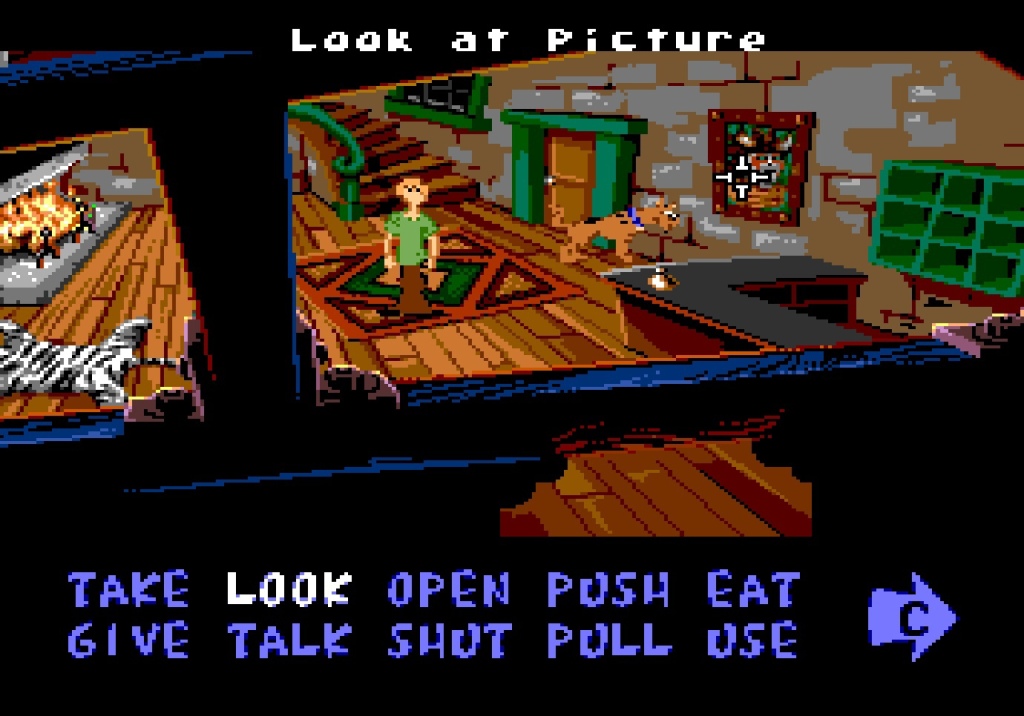
Not all commands work on everything but in general there’s LOOK AT, which will give you a description of a chosen object, TAKE, which will put it into your inventory, USE___WITH, for example “use Quarter with Snack Machine”, OPEN and SHUT, PUSH and PULL, TALK TO and GIVE___TO, and, of course, EAT, which can be used to check for clues that might have gone unnoticed or at least uneaten so far! Where relevant, this applies to stuff in the room you’re currently in or to stuff in your inventory, which you can access with a press of C. When you TALK TO someone, you’ll switch to a separate conversation mode, with text appearing on the screen and at some point presenting you with a choice of responses, which will either provide further clues or even allow you to talk your way around some of the obstacles. For a genre designed around mouse control, this is one of the better console controller implementations, and the slightly slower “mouse pointer” movement when you need to switch to that is more than compensated by the easy directional character movement when you’re looking around, and some pretty decent contextual intelligence, meaning it will quickly take you to the most obvious option, and intuitive movement between options if you want to do something else. And now we now what we’re doing, let’s fire up the Blake’s Hotel mystery and see what we can see!
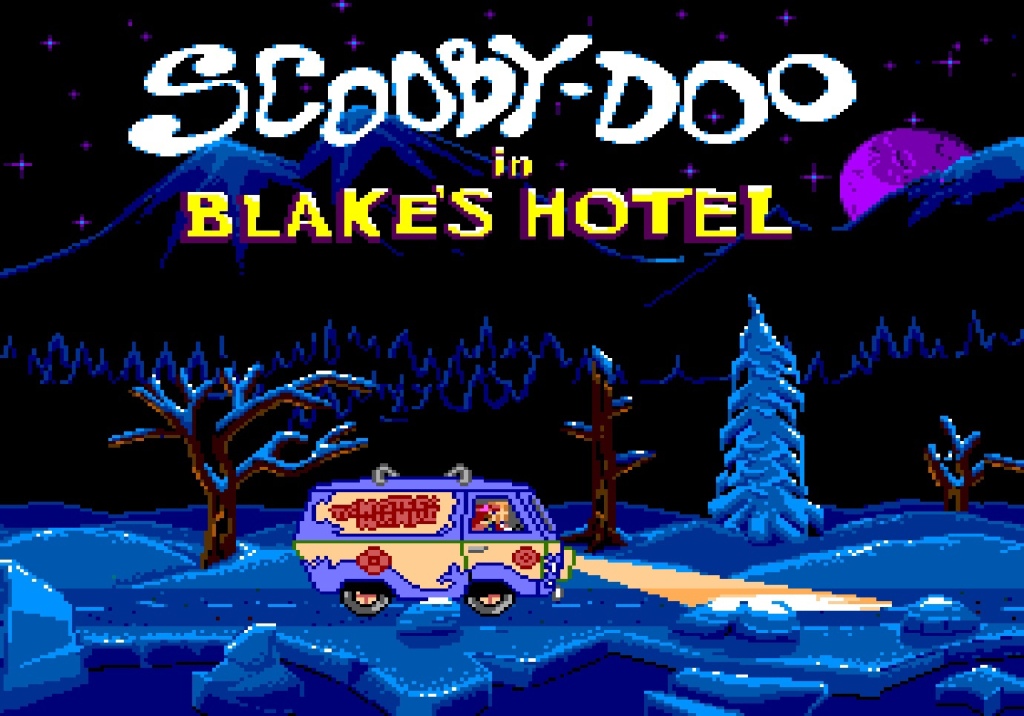
There’s more familiar music as the Mystery Machine trundles through a moonlit snowy mountain forest scene before we go inside for that windscreen view of the gang in the van from earlier as they set the scene through a text conversation on the screen, which is mostly static but brought to life by various facial movements, Fred’s hands moving on the steering wheel and occasional screen-shifting bumps in the road. It’s not exactly cartoon-quality, with lots of visible pixels, and that’s true of the characters during gameplay sequences too, but I imagine a lot of that is down to pixel-perfect viewing on a modern screen rather than the CRT it was made for, and it’s hardly a problem – if I was talking about the very similar looking Monkey Island, for example, rather than something so culturally familiar, I wouldn’t have even mentioned it! And once everything zooms out a bit, whether in further cutscenes or in gameplay (where there’s little difference between the two), we’re talking authentic Scooby Doo in location design, visual style, attention to detail and – most importantly – atmosphere.
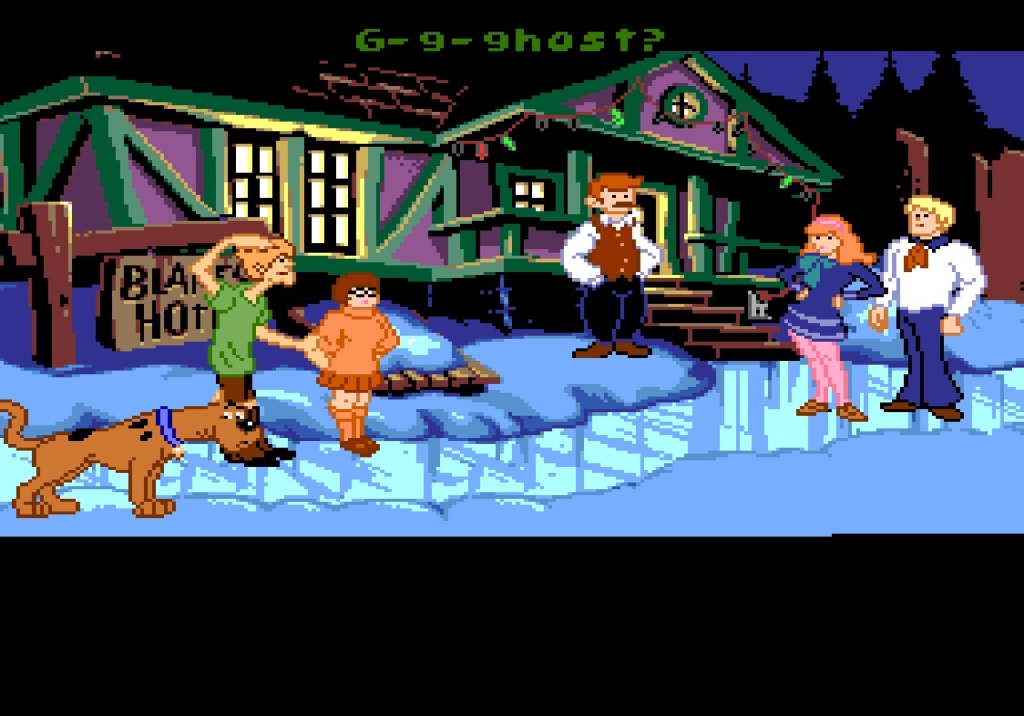
Once we arrive outside the hotel, and after an introduction to our ghost, there’s a bit more exposition from Daphne’s uncle, where we learn it started scaring the guests away about a month ago, and according to the gardener, it’s the ghost of an ancient Native American chieftain from around those parts two hundred years ago. It’s not clear why he’s suddenly unhappy with the hotel being on his land but the cook (the only other member of staff left) saw him across the river yesterday, and that’s where Fred, Velma and Daphne are off to, while Shaggy and Scooby are heading into the hotel for some room service, and we then take control of them in the lobby, with its roaring fire once again animating a mostly static scene, as is generally the case with something – such as twinkling fairy lights outside the hotel – wherever you are, although Scooby also wanders around doing his own thing and Shaggy will start scratching himself or rubbing his always-empty stomach if you leave him alone for a few seconds. The animation is as authentic as the backdrops, and I guess my only complaint is the lack of detail in Shaggy’s face most of the time – it’s literally blank when he’s facing you!
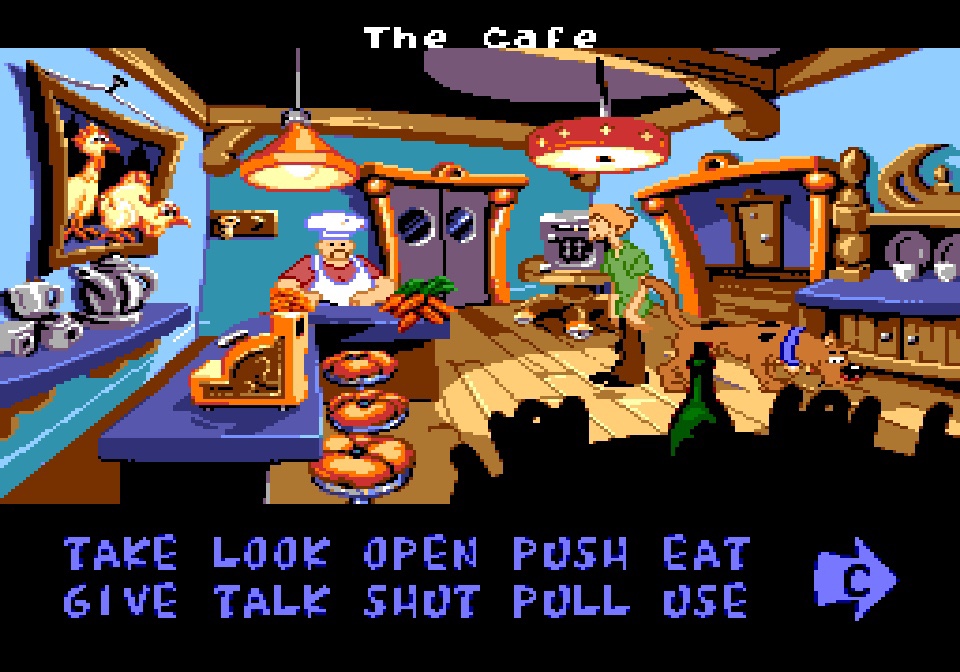
I guess there’s about fifteen locations altogether in this chapter (and the same in the other) although there’s more to some than others, such as the maze or the inevitable Scooby Doo mine you’ll come to a bit later, and some are just bigger than others, with smooth scrolling kicking in to reveal the rest as you get towards the edge of the screen. And coming back to the controls, before you’ve even left the initial lobby area on your first time playing, you’ll have got to grips with how everything works as you move and look and use, and likewise in the adjoining café, how to talk and run through the conversation trees, and if you play point-and-clicks it’s all going to feel very natural very quickly – it really is very LucasArts! And it won’t be long before it really is very Scooby Doo either, as you find the hallway with all the doors that can only mean a ghost chase in and out of every one, after a terrified close-up of Scooby and Shaggy! Thankfully that’s all played out for you too, rather than a forced action sequence that I’m never keen on when they appear in these games. Discovering the different locations in this chapter in particular was an absolute joy, with that authenticity coming into play everywhere you go, and each one holds plenty of objects to explore, items to find and secrets to uncover. And that’s the thing, because at some point fairly soon you’re going to rinse the locations you can currently get into and have to actually do something with all the stuff you’ve found, and the very best of luck to you with that!
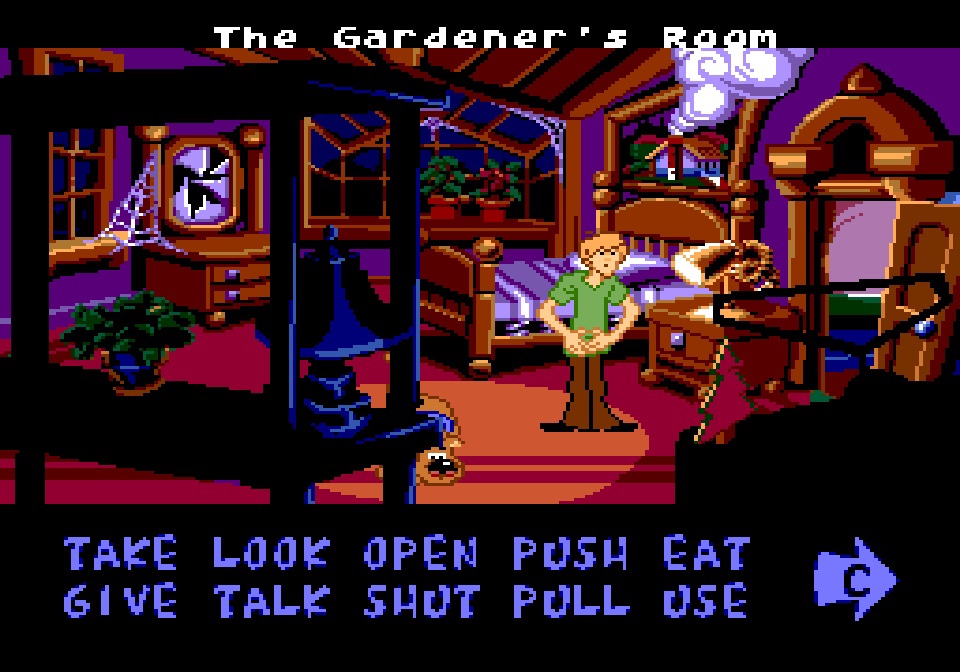
As you might have noticed previously, The Art of Point-and-Click Adventure Games refers to this game as “fleeting” which I think must be based on the very bold assumption that you not already know the solutions to all the puzzles, but also know how to identify where the puzzles actually are! Now, I’m neither going to spoil the bulk of either chapter here, nor provide some kind of walkthrough, but let me give you a couple of examples near the start of the game. That hallway with all the doors from before has one door at the end that’s locked, so it makes sense you need to find a key. There’s a key hanging on the wall behind the chef in the café so maybe if we can get rid of the chef for a minute we can grab it. The chef isn’t buying that we’re hungry though, meaning he’s not going to go and cook us something in the kitchen, so first we need to convince him of that. Which eventually is going to involve getting a bottle of antacid from that locked room, that you’re going to take to make your stomach rumble in front of him, but only after you’ve also drunk a bottle of olive oil – obviously – so how do we get into that room then? Well, we clearly don’t need that key on the wall to get in there at all, but instead we need to open every single door in that hallway in turn, each time causing the ghost to chase us in and out and around of all of them (which doesn’t seem to count as opening them), until the locked door mysteriously clicks open and we’re automatically transported inside! Again, no complaints, because it’s all classic point-and-click logic (or lack of) but I spent over an hour of this “fleeting” experience just working that out alone, and I’m only talking about the doors bit, not the olive oil and antacid concoction or what the key is for after all!
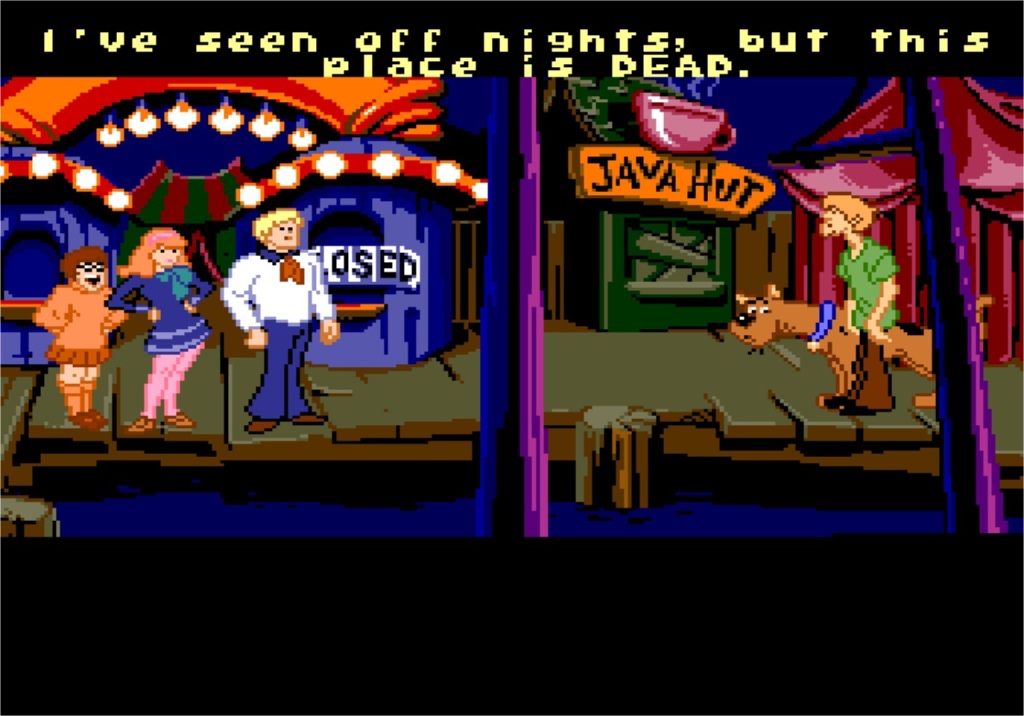
Try everything with everything always works in the end though, and slowly you’ll be revealing more and more about the hotel and its contents and its surprising surroundings, as well as all those mysteries that somehow connect together towards a classic Scooby Doo climax! I reckon I spent a good four or five hours on this chapter, which I’ll freely admit included referring to a guide a few times when I was absolutely stumped by the bonkers demands of some of the puzzles, although I can honestly say I never thought “why didn’t I think of that?” a single time when I had to resort to looking something up! And as said earlier, that also included looking up what the next puzzle actually was, rather than its solution! I think it took slightly less time for the second chapter, Ha-Ha Carnival, partly because there did seem to be a bit less to it, but I guess I was also more familiar with the format and what was being asked by the time I got there. Which is as good a time as any to do exactly that! The setup is exactly the same as before, with the gang in the Mystery Machine on the way to the carnival, but when they arrive the lights are on but nobody’s home… Except that ghost sabotaging the rollercoaster! Once again they quickly split up, with Fred, Velma and Daphne off to investigate where everyone’s gone while Scooby and Shaggy look for food, and with one more evil cackle from the ghost, that’s where we once again take control.
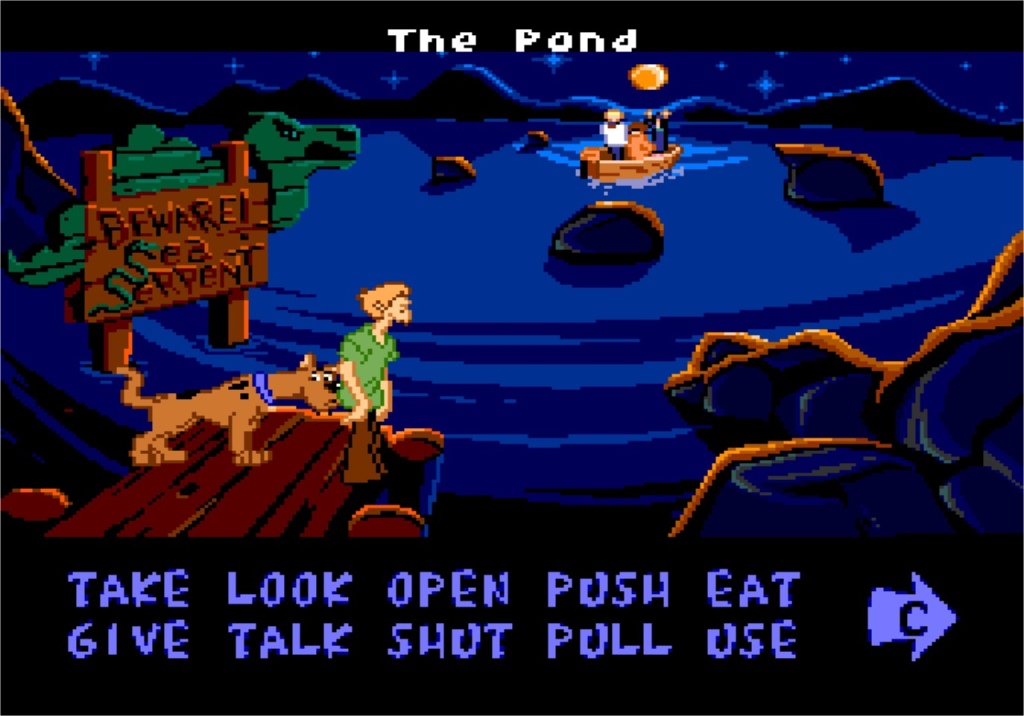
While the carnival setting might be a bit more limited in scope than the first chapter, with its hotel soon expanding into mazes and mineshafts, dungeons and burial grounds, what could be more Scooby Doo than an abandoned funfair? Well, maybe a haunted house, but it’s got one of those too, and as well as various other suitably themed locations like the hall of mirrors and the bumper car ride offering up their own unique conundrums, there’s also the totally Scooby Doo boardwalk and The Boathouse, and even a diving bell to take you underwater! Between the two chapters I think you’ve actually got most of your Scooby Doo essentials covered, and even if they might be a bit more pixel-art than hand-drawn, the effect is exactly the same and possibly more so, given the time you’ve got (and are demanded to use) to become familiar with every cobwebbed nook and cranny, potentially loose floorboard, scary portrait on the wall with suspiciously lifelike eyes or the ubiquitous taffy machine that’s bound to be needed to hold something together! Everything on every screen is beautifully crafted, vibrantly coloured and designed to catch your eye, just in case.
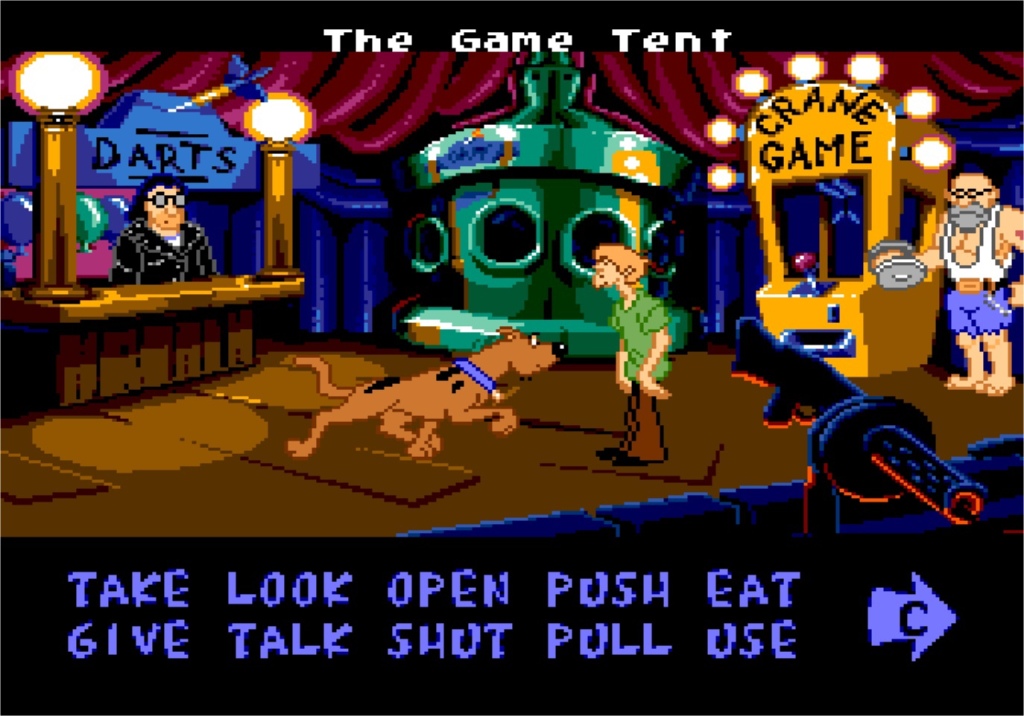
As well as deliberately avoiding this being a walkthrough, I’ve also deliberately meandered around some of the key themes, but as we’re going long I’ll quickly tie up a couple of loose ends… As well as the main theme tune and that incidental music that always plays just after it in the cartoon that you’d know immediately if you heard it now, there’s a huge variety of original music playing everywhere you go here. None of it is quite as memorable but it all serves to set the mood, from creepy, multilayered organ melodies to triumphant chip-tune trumpet blasts, or just full-on high energy nursery rhyme-type chase music as you try to escape a shrieking ghost! Which reminds me, the sampled sound effects are limited but used to great effect when they are wheeled out, with lots of incidental stuff like that and, of course, Scooby-Dooby-Doo! The last point I wanted to cover was the characterisation. As minimal as it might sometimes be, there’s more than enough in the character sprites to make them authentically recognisable, and the little unique animations and said sampled sounds elevate them further, but the writing is spot-on too, and there’s not a word said by any of the cast that’s out of place. And yes, the slapstick humour is intact too, and yes, it’s mainly built on gluttony!
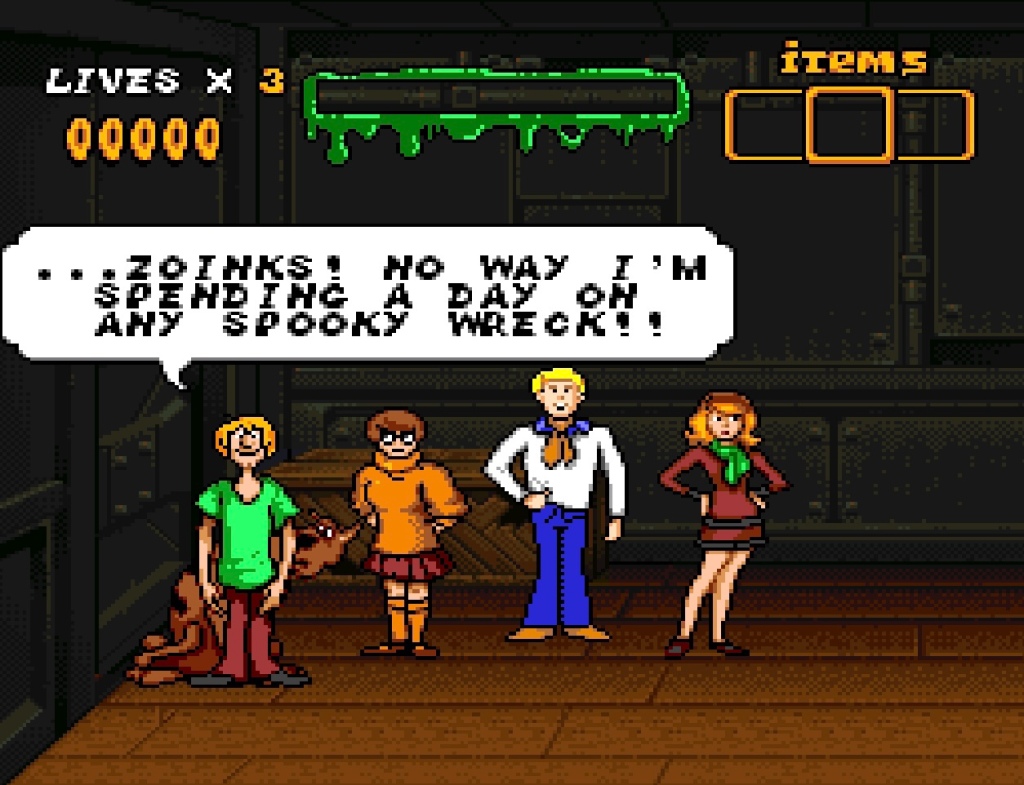
Just to close on our second chapter, I don’t think it went to all the places the first one did, literally and figuratively, and I also don’t think the puzzles were quite as out there, even if they were out there all the same! The story was probably a bit more cohesive as a result though, and as said before, you can’t have Scooby Doo without a haunted amusement park! Still felt a bit like DLC ahead of its time though. Before we close completely though, it would be remiss of me to not mention the SNES version of Scooby Doo Mystery (pictured above) because, while it’s also from the same publisher just a couple of months later in 1995, it’s a completely different game – a more action focussed game with a bit of platforming, set across four levels that represent four mysteries for you to solve. You still play as Shaggy, with Scooby in tow, and the other members of the gang sometimes appear to help out as you avoid meanies and hunt for clues across another haunted amusement park (see!), a shipwreck, a swamp and a vampire’s manor. I’ve not played a huge amount of it so can’t really comment much, and it really doesn’t bear comparison with the game I have played, but it seems competent enough and very polished, although probably more aimed at the younger audience. I’ll definitely be giving it a proper go sometime though because it also looks perfectly authentic.
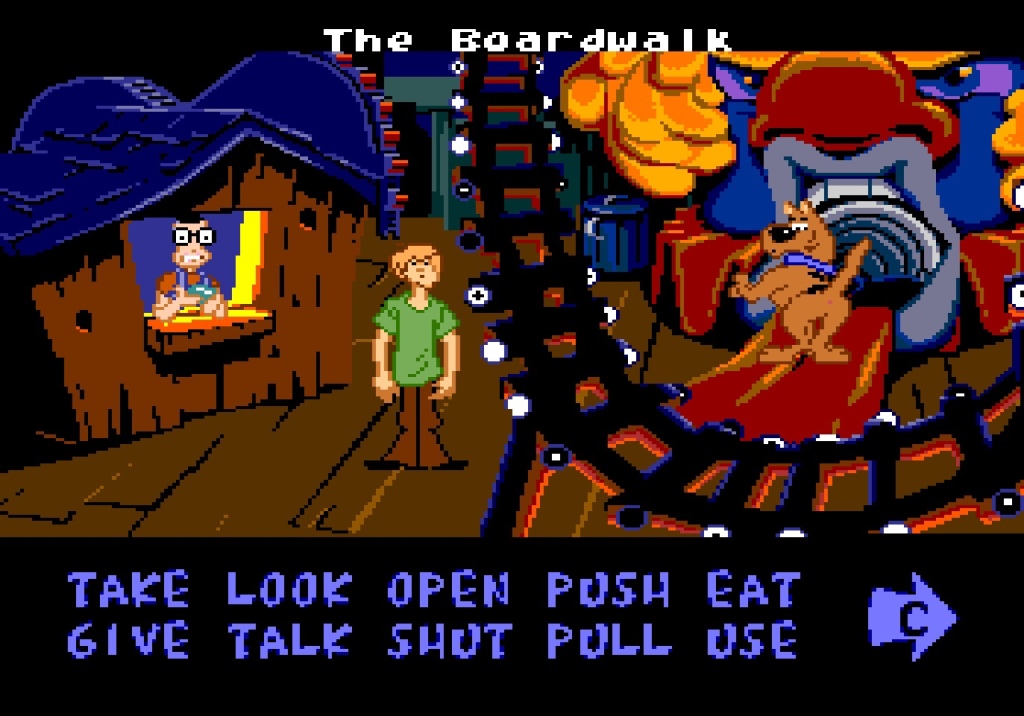
Earlier on I talked about getting stuck on a puzzle opening a door for an hour or so, but what I didn’t say at the time was I genuinely enjoyed every minute of that hour, and pretty much every one of those that followed too. And it was nothing to do with some masochistic pleasure in deriving some kind of bizarre logic from the bizarrely illogical – you really want Monkey Island or Maniac Mansion or whatever for that because these puzzles really aren’t as nuanced or sophisticated. No, what I enjoyed was this game’s (or games’) absolute triumph in giving me the interactive Scooby Doo cartoon I’d been after for nearly forty years! It’s not only a pair of proper Scooby Doo mysteries with proper Scooby Doo writing for a proper Scooby Doo cast of characters, but it nails everything else too – the sights, the sounds and not least the wonderful creepy, late sixties-gothic vibe that is proper Scooby Doo!

